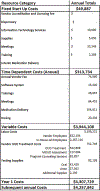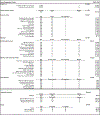Budget impact tool for the incorporation of medications for opioid use disorder into jail/prison facilities
- PMID: 36880906
- PMCID: PMC10084043
- DOI: 10.1016/j.josat.2022.208943
Budget impact tool for the incorporation of medications for opioid use disorder into jail/prison facilities
Abstract
Background: Given the personal and public consequences of untreated/undertreated OUD among persons involved in the justice system, an increasing number of jails and prisons are incorporating medication for opioid use disorder (MOUD) into their system. Estimating the costs of implementing and sustaining a particular MOUD program is vital to detention facilities, which typically face modest, fixed health care budgets. We developed a customizable budget impact tool to estimate the implementation and sustainment costs of numerous MOUD delivery models for detention facilities.
Methods: The aim is to describe the tool and present an application of a hypothetical MOUD model. The tool is populated with resources required to implement and sustain various MOUD models in detention facilities. We identified resources via micro-costing techniques alongside randomized clinical trials. The resource-costing method is used to assign values to resources. Resources/costs are categorized as (a) fixed, (b) time-dependent, and (c) variable. Implementation costs include (a), (b), and (c) over a specified timeframe. Sustainment costs include (b) and (c). The MOUD model example entails offering all three FDA-approved medications, with methadone and buprenorphine provided by vendors, and naltrexone by the jail/prison facility.
Results: Fixed resources/costs are incurred only once, including accreditation fees and trainings. Time-dependent resources/costs are recurring, but fixed over a given time-period; e.g., medication delivery and staff meetings. Variable resources/costs are those that are a direct function of the number of persons treated, such as the medication provided to each patient. Using nationally representative prices, we estimated fixed/sustainment costs to be $2919/patient, over 1 year. This article estimates annual sustainment costs to be $2885/patient.
Conclusion: The tool will serve as a valuable asset to jail/prison leadership, policymakers, and other stakeholders interested in identifying/estimating the resources and costs associated with alternative MOUD delivery models, from the planning stages through sustainment.
Keywords: Budget impact tool; Guideline; Incarceration; Jail; Medication for opioid use disorder; Prison.
Copyright © 2023 The Authors. Published by Elsevier Inc. All rights reserved.
Conflict of interest statement
Declaration of competing interest No competing interests to declare.
Figures
Similar articles
-
Cost analysis of MOUD implementation and sustainability in Massachusetts jails.Health Justice. 2025 Feb 5;13(1):9. doi: 10.1186/s40352-025-00321-z. Health Justice. 2025. PMID: 39907840 Free PMC article.
-
Expanding access to Medication for Opioid Use Disorder (MOUD) in jails: A comprehensive program evaluation.J Subst Use Addict Treat. 2024 Jun;161:209248. doi: 10.1016/j.josat.2023.209248. Epub 2023 Dec 9. J Subst Use Addict Treat. 2024. PMID: 38081540
-
Massachusetts Justice Community Opioid Innovation Network (MassJCOIN).J Subst Abuse Treat. 2021 Sep;128:108275. doi: 10.1016/j.jsat.2021.108275. Epub 2021 Jan 8. J Subst Abuse Treat. 2021. PMID: 33483222 Free PMC article.
-
The Impact of Medications for Opioid Use Disorder on Hepatitis C Incidence Among Incarcerated Persons: A Systematic Review.Infect Dis Clin North Am. 2020 Sep;34(3):559-584. doi: 10.1016/j.idc.2020.06.011. Infect Dis Clin North Am. 2020. PMID: 32782102 Free PMC article.
-
Effectiveness of medication assisted treatment for opioid use in prison and jail settings: A meta-analysis and systematic review.J Subst Abuse Treat. 2019 Apr;99:32-43. doi: 10.1016/j.jsat.2018.12.003. Epub 2018 Dec 15. J Subst Abuse Treat. 2019. PMID: 30797392 Free PMC article.
Cited by
-
Budget Impact Tool for Implementing Contingency Management for Co-occurring Alcohol Use Disorders and Serious Mental Illness.Psychiatr Serv. 2024 Apr 1;75(4):326-332. doi: 10.1176/appi.ps.20220547. Epub 2023 Oct 19. Psychiatr Serv. 2024. PMID: 37855102 Free PMC article.
-
Identifying and responding to policy-related barriers, facilitators, and misunderstandings in the HEALing communities study: A community-driven approach.Int J Drug Policy. 2025 Aug;142:104851. doi: 10.1016/j.drugpo.2025.104851. Epub 2025 May 22. Int J Drug Policy. 2025. PMID: 40409135
-
Informing evidence-based medicine for opioid use disorder using pharmacoeconomic studies.Expert Rev Pharmacoecon Outcomes Res. 2024 Jun;24(5):599-611. doi: 10.1080/14737167.2024.2350561. Epub 2024 May 9. Expert Rev Pharmacoecon Outcomes Res. 2024. PMID: 38696161 Free PMC article. Review.
-
Development and usability testing of a tool to estimate the budget impact of implementing a smoking cessation intervention for cancer patients.Cancer Causes Control. 2025 Aug;36(8):747-753. doi: 10.1007/s10552-025-01976-7. Epub 2025 Mar 4. Cancer Causes Control. 2025. PMID: 40038171
-
Medicaid Inmate Exclusion Policy and Infectious Diseases Care for Justice-Involved Populations.Emerg Infect Dis. 2024 Apr;30(13):S94-S99. doi: 10.3201/eid3013.230742. Emerg Infect Dis. 2024. PMID: 38561870 Free PMC article. Review.
References
-
- Bronson J, Stroop J, Zimmer S, and Berzofsky M. (2017). Drug use, dependence, and abuse among state prisoners and jail inmates, 2007–2009. https://bjs.ojp.gov/content/pub/pdf/dudaspji0709.pdf
-
- Bureau of Labor Statistics. (2021). Occupational Outlook Handbook. Retrieved 7/28 from https://www.bls.gov/ooh/home.htm
-
- Carroll KM, Ball SA, Martino S, Nich C, Babuscio TA, Nuro KF, Gordon MA, Portnoy GA, & Rounsaville BJ (2008). Computer-assisted delivery of cognitive-behavioral therapy for addiction: a randomized trial of CBT4CBT. Am J Psychiatry, 165(7), 881–888. 10.1176/appi.ajp.2008.07111835 - DOI - PMC - PubMed
Publication types
MeSH terms
Substances
Grants and funding
LinkOut - more resources
Full Text Sources
Medical








